Harbour Board Gates
Heritage object

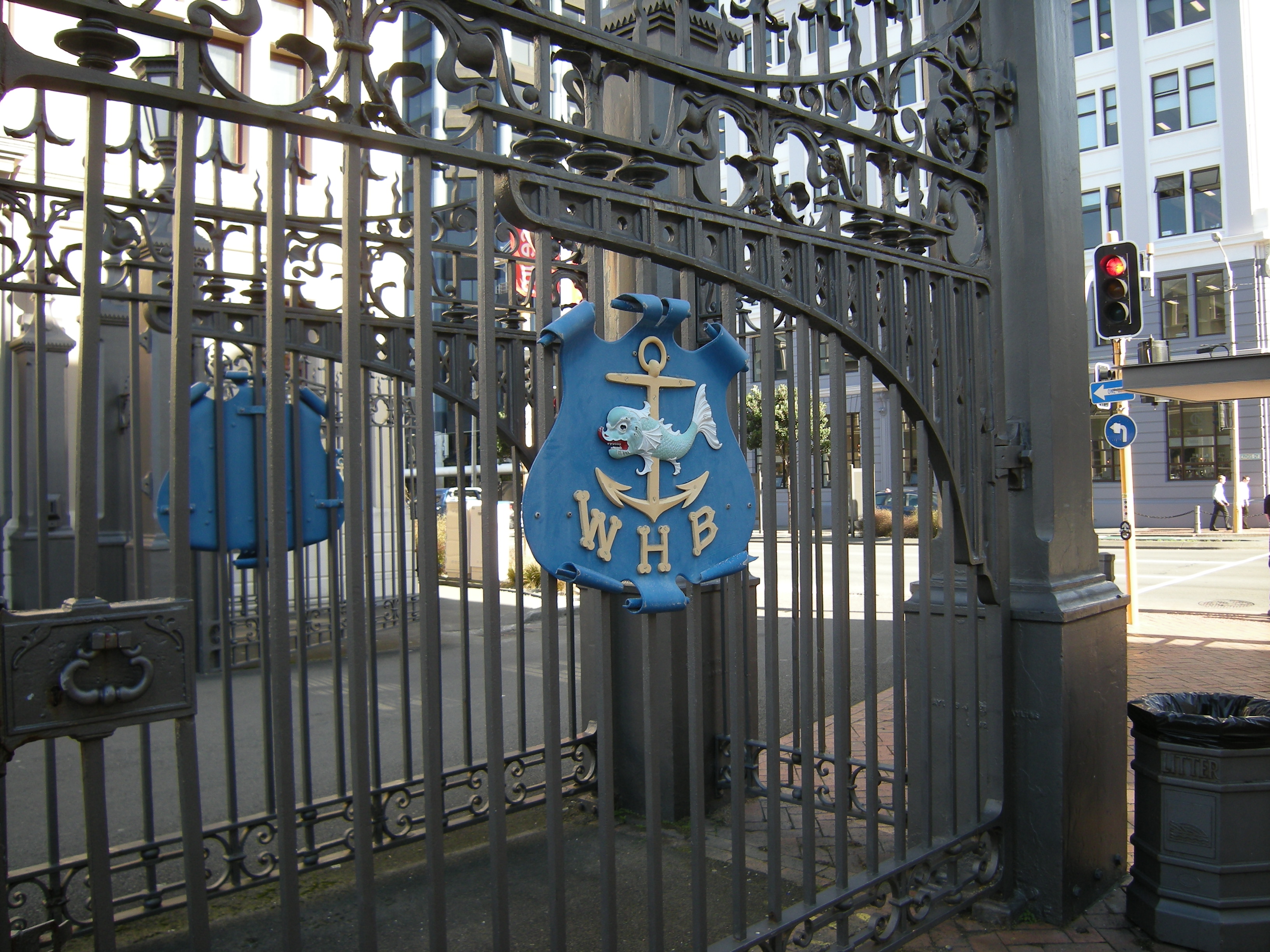
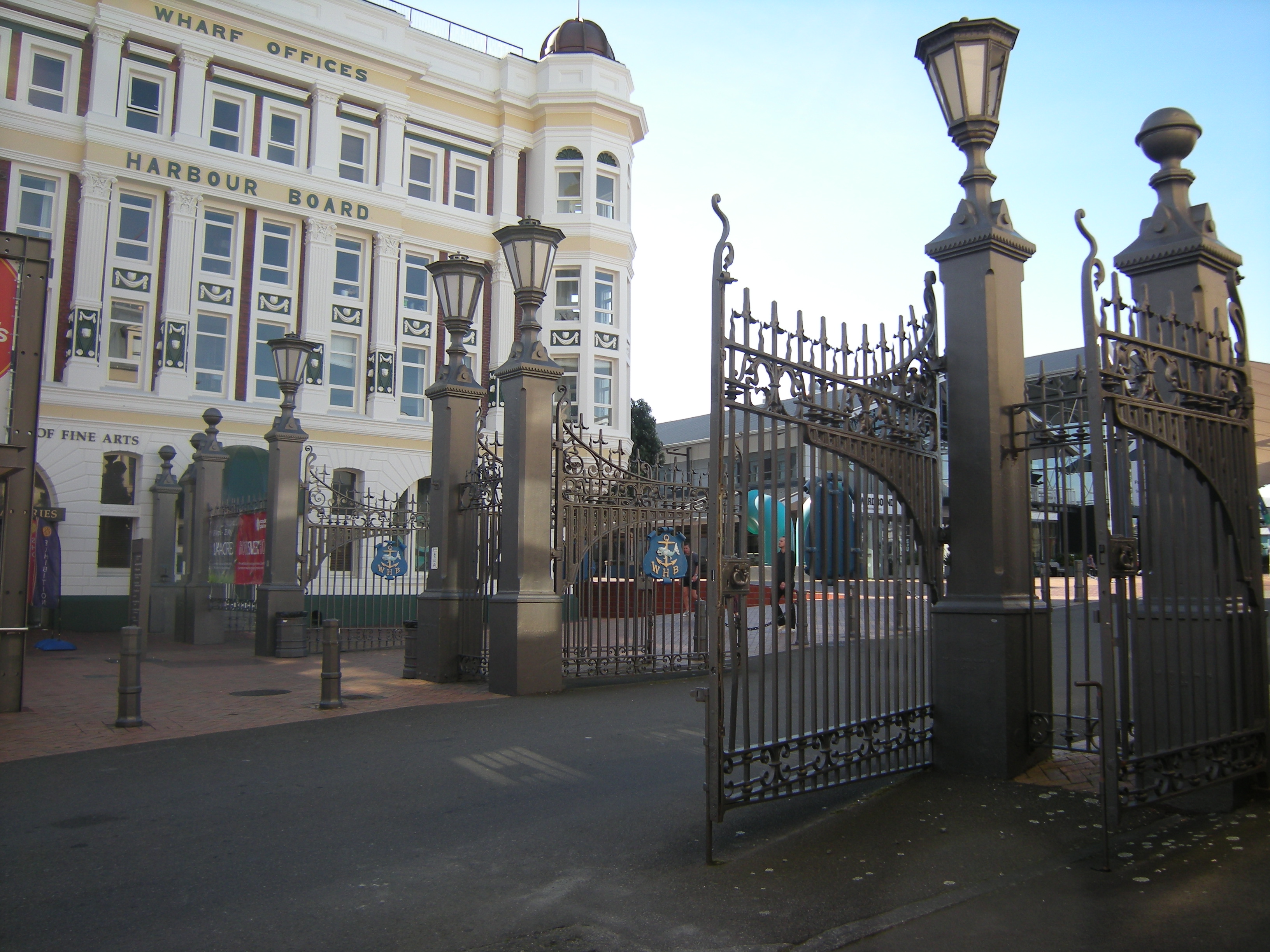
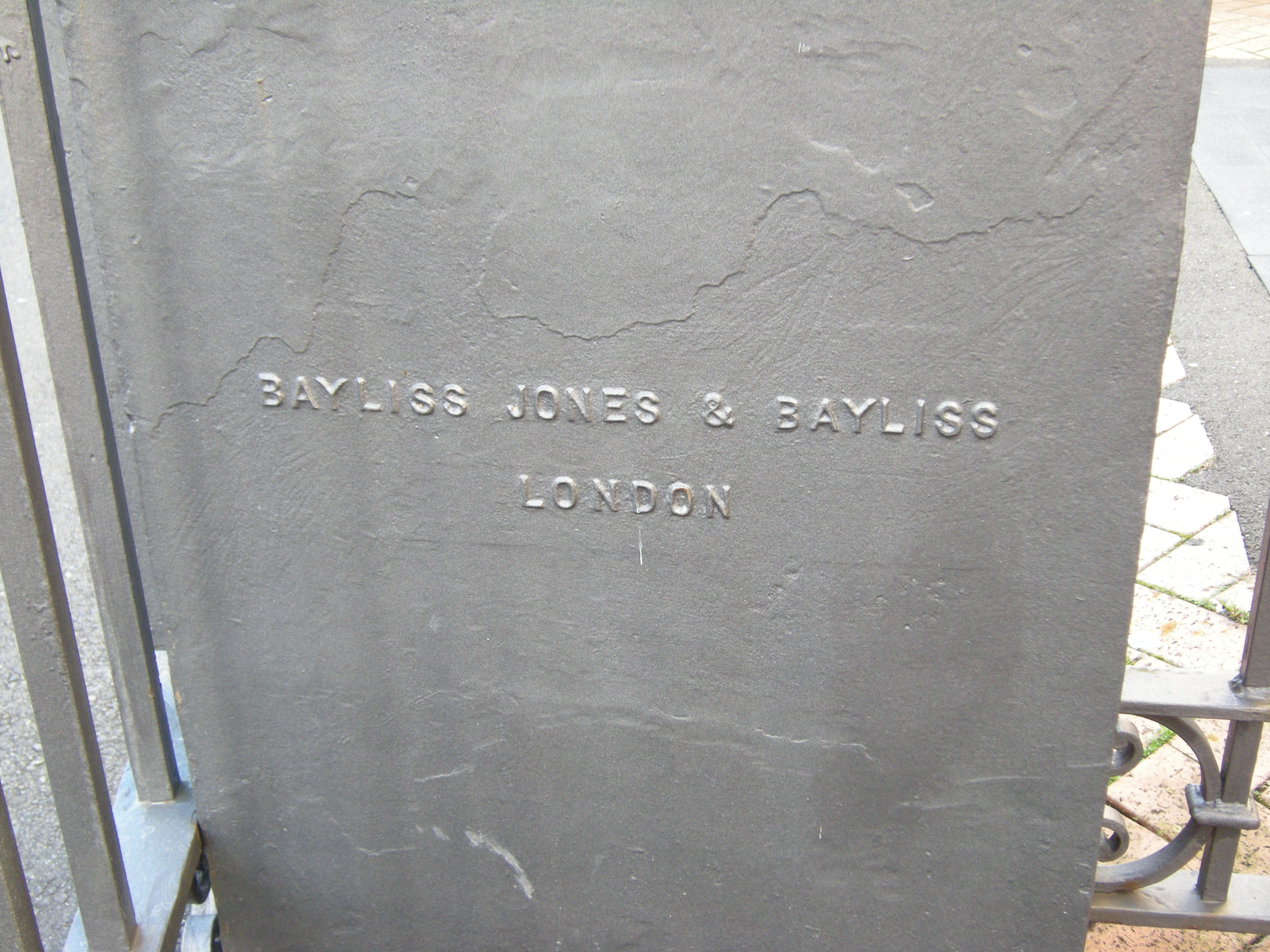
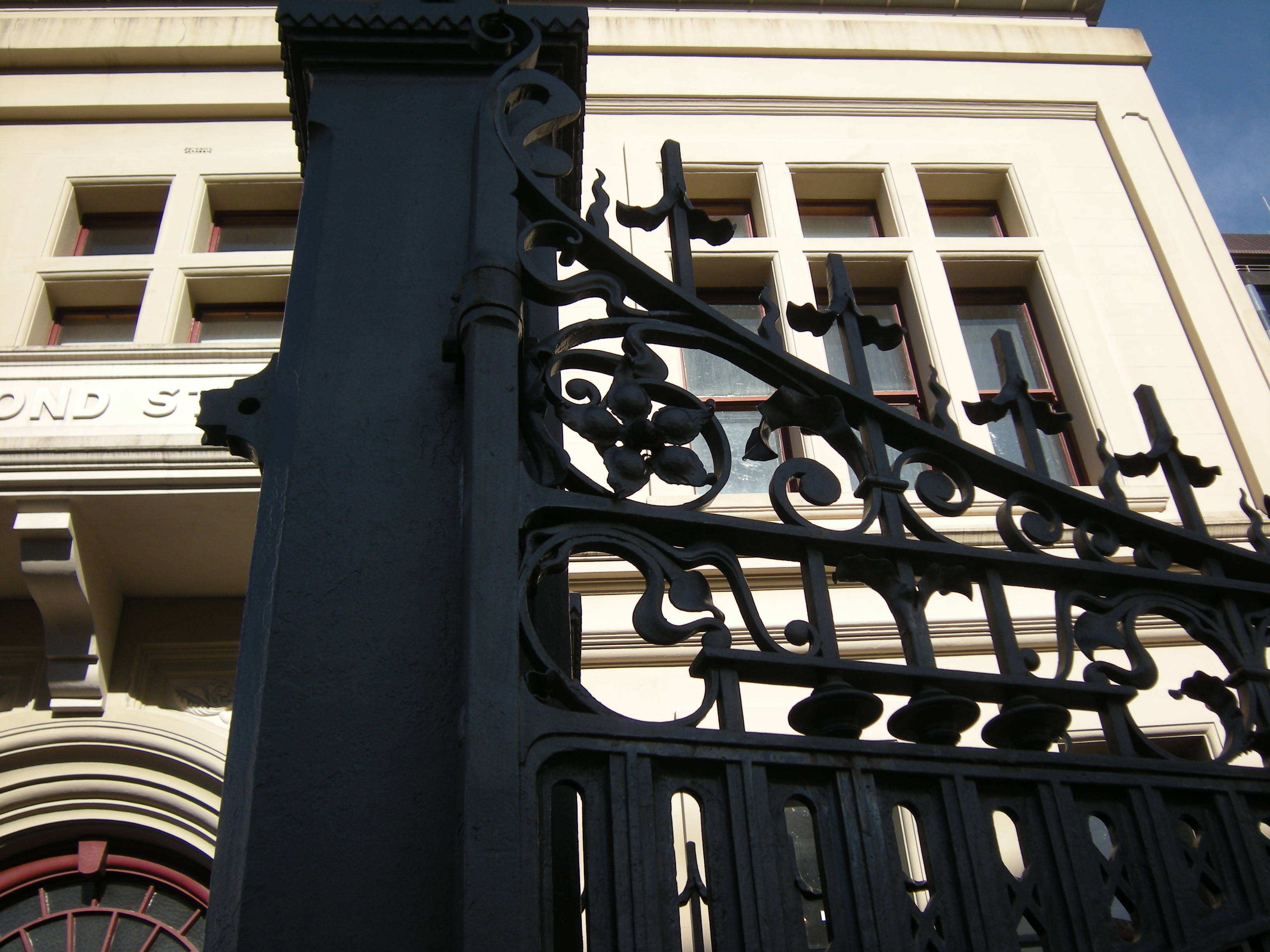
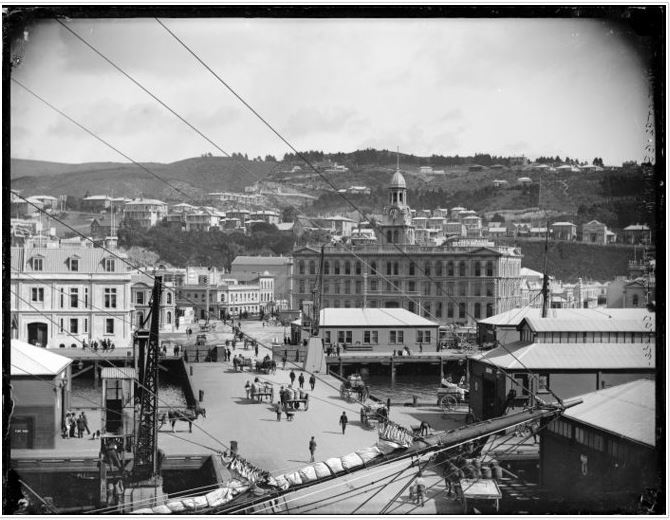
1892 – Queen’s Wharf. Note the timber fence and sentry box at the head of the wharf. The photograph was taken before the construction of the Wellington Harbour Board Office/Woolstore in 1896 and the old central post office and clock tower can be seen in the mid-distance.
Image: National Library reference "Queens Wharf, Wellington. Wright, Henry Charles Clarke, 1844-1936: Negatives. Ref: 1/1-020457-G. Alexander Turnbull Library, Wellington, New Zealand. http://natlib.govt.nz/records/23140085 "
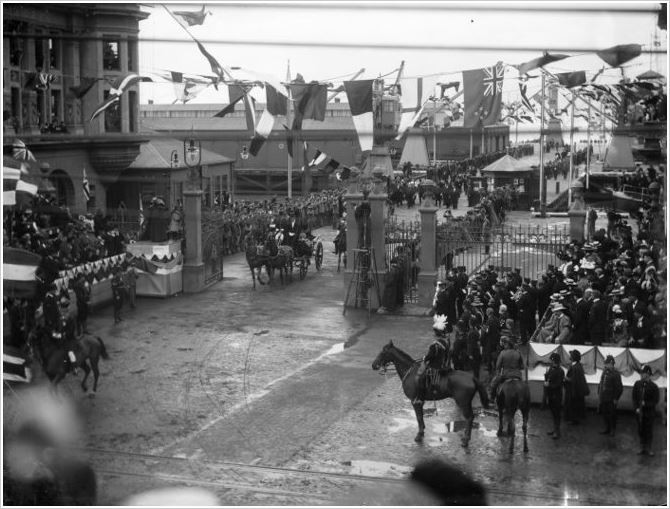
1901 – Queen’s Wharf gates as the official “entrance” to the city for the arrival of the Duke and Duchess of Cornwall and York.
Image: National Library reference "Royal procession, Queen's Wharf, Wellington. McAllister, James, 1869-1952: Negatives of Stratford and Taranaki district. Ref: 1/1-007950-G. Alexander Turnbull Library, Wellington, New Zealand.http://natlib.govt.nz/records/22830912 "
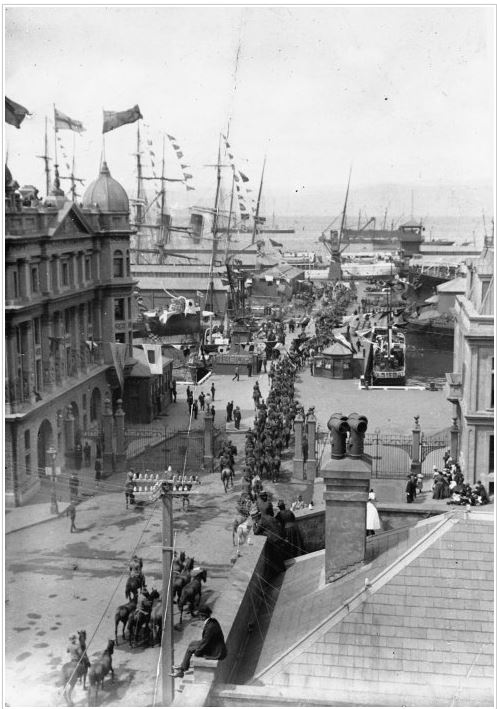
Between 1899 – 1902. Troops depart for the South African Wars from Queen’s Wharf. Note that the harbour gates are closed.
Image: National Library reference "Chatfield. New Zealand troops departing for the South African War, Queens Wharf, Wellington. Ref: 1/2-110815-F. Alexander Turnbull Library, Wellington, New Zealand. http://natlib.govt.nz/records/22890819 "
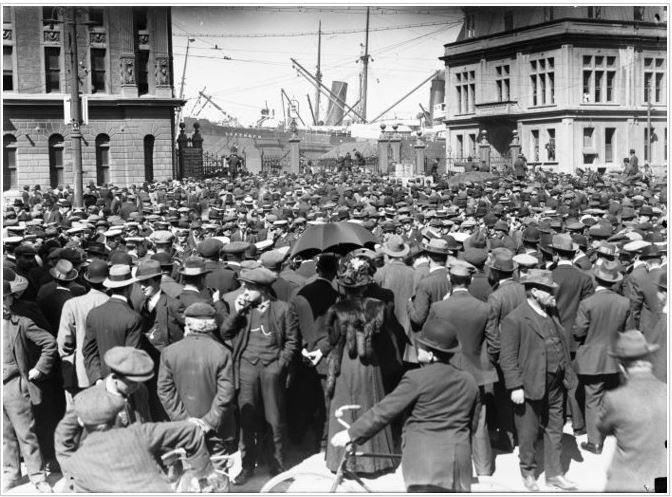
1913 – Crowd at Queen’s Wharf, Wellington, during the 1913 Waterfront Strike. Note the people, possibly children, who are climbing or sitting on the gates.
Image: National Library reference "Crowd at Queens Wharf, Wellington, during the 1913 Waterfront Strike. Smith, Sydney Charles, 1888-1972: Photographs of New Zealand. Ref: 1/2-046169-G. Alexander Turnbull Library, Wellington, New Zealand.http://natlib.govt.nz/records/22836257 "
![QUEEN'S WHARF ENTRANCE.-A new centre light has been ins... [truncated] Evening Post, 28 July 1934, Page 11](/~/media/heritage/buildings/objects/50-harbour-board-gates/image14.ashx?mw=671&mh=415)
1934 – A “new centre light has been installed by the Harbour Board at the entrance to Queen’s Wharf. Of the lantern type, it is more in accordance with the design of the gates.”
Image: QUEEN'S WHARF ENTRANCE.-A new centre light has been ins... [truncated] Evening Post, 28 July 1934, Page 11
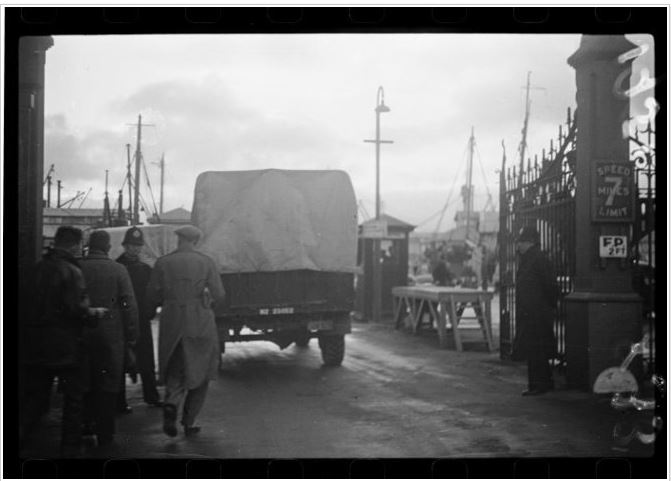
1951 – Watersiders arriving for work during the 1951 waterfront dispute.
Image: National Library reference "Watersiders arriving for work during the 1951 waterfront dispute. Negatives of the Evening Post newspaper. Ref: 114/307/10/13-F. Alexander Turnbull Library, Wellington, New Zealand. http://natlib.govt.nz/records/23231000 "
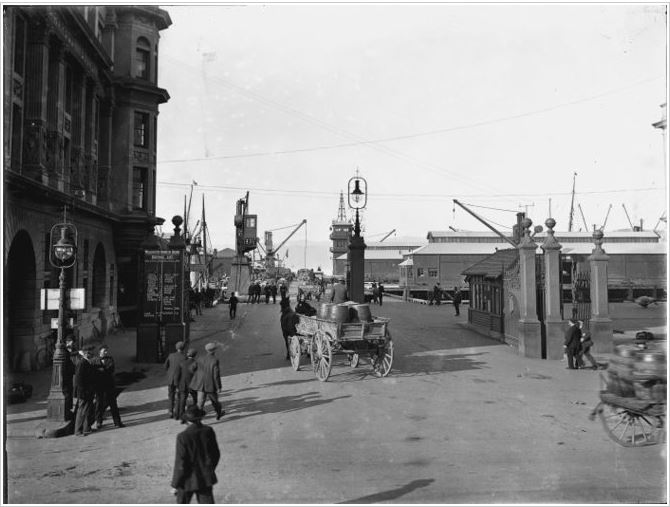
Image: National Library reference "Entrance to Queen's Wharf, Wellington. Smith, Sydney Charles, 1888-1972: Photographs of New Zealand. Ref: 1/1-019642-G. Alexander Turnbull Library, Wellington, New Zealand. http://natlib.govt.nz/records/23221954 "
-
Constructed
1899
-
Heritage Area
-
Architect(s)
-
Builder(s)
Wolverhampton and London
-
The Queen’s Wharf gates are a particularly fine set of Art Nouveau inspired Victorian gates and are notable for the quality of their design, materials and workmanship.
The gates have townscape value as the formal entrance to the Wellington waterfront at a key nodal point – Queen’s Wharf and Post Office Square. The gates have group value as part of the Post Office Square Heritage Area, and as part of a collection of heritage buildings and objects that are associated former Wellington Harbour Board.
The gates have a strong historic association with the Wellington Harbour Board and were instrumental to the way in which the waterfront was secured and managed. They were used to restrict public access to the waterfront for over 90 years from 1899 to c.1989 and have a close association with the departure of troops to the South African Wars. They were also used to bar striking workers during two of New Zealand’s best known and bitter industrial disputes – the 1913 and 1951 waterfront strikes. -
Downloadable(s)
-
close
History
-
This set of Wellington Harbour Board gates were fabricated by Bayliss Jones and Bayliss of Wolverhampton and London, and fixed at the entrance to Queen’s Wharf in 1899. They formed the symbolic ‘entrance’ to the city at a time when maritime (and rail) transport were the key means of long-distance travel.
The Wellington Harbour Board gates are symptomatic of the development of Wellington’s port facilities from a landing beach for Pipitea Pa, to the current container, shipping and cruise-liner terminal at Aotea Quay. Commercial wharves were built in Wellington harbour from c.1840 onwards and were designed to suit lighters (barges) that were operated by licensed watermen and which transported goods between the ships and wharves for a set fee. Wellington’s first deepwater wharf was built in 1862 in the shape of a double ‘T’ and later became known as the Queen’s Wharf. It was the second major work by the Provincial Council and lay to the east of the council’s 1857-63 Clay Point to Panama Street reclamation.
The Wellington City Corporation was formed in 1870 and was responsible for the port until the establishment of the Wellington Harbour Board in c.1880. The harbour board had a mandate to develop and operate the port facilities and, as part of this work, built a strategic series of sheds and buildings along its western boundary. This boundary was then ‘in-filled’ between 1899 and 1922 with a series of fences and gates that extended from Waterloo, Jervois, and Customhouse quays to Taranaki Street. The Queen’s wharf gates were the first to be installed and were fitted at the city’s key transit node for sea, rail, tram and road transportation, and for postal and telegraphic communications – Post Office Square.
The gates also mark the administrative centre of the Wellington Harbour Board and were fixed between the 1892 Wellington Harbour Board Office/Bond store that is now the Museum of Wellington City & Sea (WCC17/160), and the 1896 Wharf Office/Woolstore that was later renamed ‘Shed 7’ (WCC 17/161). The new fence and gates were used, in conjunction with Harbour Board bylaws, to restrict access and control commercial activity within the wharf area. They replaced a smaller timber fence and sentry box arrangement that once stood at the end of Queen’s Wharf.
The harbour board gates were seen by the Wellington Harbour Board as a means of protecting the public from the workings of a busy port. The wharves were a dangerous place and were notorious for overcrowding, particularly at embarkation and disembarkation of passenger ships, for industrial accidents and for the deaths by drowning of passers-by who fell from the wharfs, particularly while drunk. This new ability to restrict public access to the waterfront was not universally popular. The right of public access to the waterfront was a long held belief by the citizens of Wellington and the installation of the Queen’s Wharf gates in 1899 meant that the public were more or less excluded from their favourite promenades.
The gates were first used strategically as crowd control for the departure of the second New Zealand contingent to the South African Wars in January 1900. They later became identified with political unrest, especially during the waterfront strike of 1913 when they were used to control access to the wharves both by the police and unionists. WWII saw further restrictions to public access to the waterfront, although these were relaxed in March 1942 and the public were admitted to a small area. Further restrictions were imposed in 1951 when the Wellington Harbour Board closed its gates to unionised workers and used troops to load and unload ships under a heavy police presence.
Passenger and freight transportation were revolutionised in the c.1960s with the growing popularity of air-travel and containerisation. A modern container terminal was established near Wellington’s railway station and many of the traditional waterfront facilities to the south of Aotea Quay became redundant. Restrictions to public access to the old wharves began to change in the closing decades of the twentieth century and accelerated when the Wellington Harbour Board was disbanded in 1989. Control of the waterfront was divided into two commercial enterprises; the commercial port to the north of Wellington railway station at Aotea Quay run by Centreport, and a “public recreation destination” to the south run by Wellington Waterfront Ltd.
The transformation of the old working port into a commercial, residential and recreational precinct has led to the adaptation, re-use and demolition of much of the harbour board’s infrastructure. Public access to the waterfront has led to the loss of the majority of the old harbour board fences, gates and boundary markers. The Taranaki Street gates (WCC 17/53), and the fencing and gates that run from just north of Shed 13 to the entrance to the carpark of the TSB Arena, are some of the last remaining vestigial remnants of an important piece of industrial, maritime and social history.The Queen's Wharf Gates
The Queen’s Wharf gates were the first of the Wellington Harbour Board Gates to be erected. They were prefabricated by Bayliss, Jones and Bayliss of Wolverhampton and London despite arguments that the contract should have been awarded to a local foundry. The cost was estimated at £2000.
The Queen’s Wharf gates became a standard template for all of the later harbour board fences, gates and boundary markers. They were altered in 1934 when a new lamp was added to the central posts.
The gates have been substantially reconfigured, and further light fittings were added. This presumably occurred in the mid-1990s to coincide with the development of the nearby TSB Arena and associated commercial buildings.
-
Modifications
close
-
1899
-
Construction
-
1934
-
Central light fitting added
-
-
Occupation History
close
Not assessed
-
This set of Wellington Harbour Board gates were fabricated by Bayliss Jones and Bayliss of Wolverhampton and London, and fixed at the entrance to Queen’s Wharf in 1899. They formed the symbolic ‘entrance’ to the city at a time when maritime (and rail) transport were the key means of long-distance travel.
-
close
Architectural Information
-
Building Classification(s)
close
Not assessed
-
Architecture
close
The Queen’s Wharf gates were prefabricate in a mix of rolled, cast and wrought iron and were shipped to New Zealand in 1899. The screen is made up of wrought/rolled iron pedestrian gates, pairs of vehicular access gates, fixed fence panels, and pairs of cast iron gateposts topped with either orbs or lanterns.
The original configuration appears to have been (from north to south) small gate post, pedestrian gate, two gate posts, pair of vehicular gates, gate post with lantern, pair of vehicular gates, two gate posts, pedestrian gate, small gate post, pair of vehicular gates, small gate post, pedestrian gate, small gate post.
The current configuration is likely to date from the mid-1990s and they key changes include the loss of one of the pairs of vehicular gates, the rearrangement of the tall and short gate posts, and the addition of lantern lights and fixed panels. The fixed panel to the north of the main vehicular gates is a strange newcomer and, for some inexplicable reason, sits approx half a metre above the finished ground level.
The original gate posts have been cast in two different sizes – a tall and a short. The size is differentiated only by the length of the column as the base and ‘capital’ are otherwise identical. The posts are square in plan and are either topped by an orb or a lantern. The central light was replaced with a lantern in 1934 and further lanterns were added later, presumably in the mid-1990s. The lanterns and orbs are fixed to a circular plate and the transition between the angular to the spherical is broached through an inverse fluted pedestal. This intersects with a tri-petal gable shape on each of the four sides of the post. The cornice at the top of the post features a zig-zag pattern.
Although the gates are not as elaborate as some late Victorian and Edwardian ironwork, they are certainly influenced by the fluidity of form found in Art Nouveau architecture. The top section of the gate sweeps up to meet the top of the tallest gate posts. It is in-filled and topped with stylised floral and leaf-forms. The gate bracing is made up of a band of subtly enlarged pickets and sits directly beneath the top decorative band. This too has been treated as an arc, and the overall effect is of the gates as pairs of sweeping wings.
The gates are topped by a line of finials along the concave top-rail. These alternate between a long straight pyramid tipped picket decorated with an Art Nouveau leaf shape, and a shorter waved picket that terminates at a point.
The locks and handles carry on with the Art Nouveau theme, but the lowest row of decoration/strengthening has less fluidity and is made up of a row of scrolls and bars. The simple drop bolts are functional and in character with the quality and design of the gates.
The key difference between the Queen’s Wharf gates and the remaining harbour board gates and railings is the presence of the Wellington Harbour Board insignia on each gate panel. The inclusion of the insignia at the Queen’s Wharf gates seems to have been prompted because the gates were the prime entrance to the Wellington Harbour Board’s main wharf, which was also its administrative centre.
-
Materials
close
Cast iron elements (orbs & posts)
Rolled iron (palings) with some cast iron elements
Wrought iron decorative elements
-
Setting
close
The Queen’s Wharf gates are set between Shed 7 and the former Harbour Board Office to form a physical barrier between the city and harbour.
To the immediate east of the gates is the large modern TSB arena building and a similar modern office building. In the middle distance are other wharf-side industrial buildings / sheds, many of which have been converted to restaurants/bars/ and other recreational use, and beyond them the sea. To the west of the gates is the busy arterial route of Jervois Quay and Customhouse Quay and beyond that a mix of high and low rise commercial buildings.
The Queen’s Wharf gates are also part of the Post Office Square Heritage Area, and this heritage area includes other listed objects such as a telephone box (c.1938) and post box (c.1879-1910), and listed buildings that include the diminutive Clarrie Gibbon’s building/former tram shed and traffic island (1912), Head Office and Bond Store (Museum of Wellington - City and Sea, 1891-92), Shed 11 (1904-05), Shed 13 (1904-05), Huddart Parker Building, 2-6 Jervois Quay (1924), and the Tower Building, 50 – 64 Customhouse Quay (1936).
Further groupings of former harbour board gates stretch from just north of Shed 13 to just south of the Museum of Wellington City and Sea, and the Taranaki Street gates (also listed on the WCC heritage inventory) to the far south of the harbour area.
-
Building Classification(s)
close
-
close
Cultural Value
The Queen’s Wharf gates are a particularly fine set of Art Nouveau inspired Victorian gates and are notable for the quality of their design, materials and workmanship.
The gates have townscape value as the formal entrance to the Wellington waterfront at a key nodal point – Queen’s Wharf and Post Office Square. The gates have group value as part of the Post Office Square Heritage Area, and as part of a collection of heritage buildings and objects that are associated former Wellington Harbour Board.
The gates have a strong historic association with the Wellington Harbour Board and were instrumental to the way in which the waterfront was secured and managed. They were used to restrict public access to the waterfront for over 90 years from 1899 to c.1989 and have a close association with the departure of troops to the South African Wars. They were also used to bar striking workers during two of New Zealand’s best known and bitter industrial disputes – the 1913 and 1951 waterfront strikes.
-
Aesthetic Value
close
-
Architectural
Does the item have architectural or artistic value for characteristics that may include its design, style, era, form, scale, materials, colour, texture, patina of age, quality of space, craftsmanship, smells, and sounds?
The Queen’s Wharf gates are a particularly fine set of Art Nouveau inspired Victorian gates and are notable for the quality of their design, materials and workmanship.
-
Group
Is the item part of a group of buildings, structures, or sites that taken together have coherence because of their age, history, style, scale, materials, or use?
The gates are the major element in a group of remaining former Wellington Harbour Board fences and gates that once stretched along Waterloo, Jervois, and Customhouse Quays to Taranaki Street.
The gates also form part of the Post Office Square Heritage Area, and are part of a collection of heritage buildings and objects that have an association with the former Wellington Harbour Board and waterfront.
-
Townscape
Does the item have townscape value for the part it plays in defining a space or street; providing visual interest; its role as a landmark; or the contribution it makes to the character and sense of place of Wellington?
The gates are the entrance to the Wellington waterfront at a key nodal point – Queen’s Wharf and Post Office Square.
-
-
Historic Value
close
-
Association
Is the item associated with an important historic event, theme, pattern, phase, or activity?
The gates were used to exclude public access to the waterfront for over 90 years from 1899 to c.1989. They were used for crowd control during key embarkations including the departure of troops to the South African Wars, and during royal visits. The gates are also closely connected with two of New Zealand’s best known and bitter industrial disputes, and were used to bar striking workers during the 1913 and 1951 waterfront strikes.
-
Association
Is the item associated with an important person, group, or organisation?
The gates have a strong historic association with the Wellington Harbour Board and were instrumental to the way in which the waterfront was secured and managed.
-
-
Scientific Value
close
-
Archaeological
Does the item have archaeological value for its ability to provide scientific information about past human activity?
Pre 1900 reclaimed land & Central City NZAA R27/270
-
Educational
Does the item have educational value for what it can demonstrate about aspects of the past?
The Queen’s Wharf gates are a reminder of the infrastructure required to run a working port in the late 19th to mid 20th centuries
-
Technological
Does the item have technological value for its innovative or important construction methods or use of materials?
The gates have technological value as an example of wrought and cast iron work of a type that is no longer produced on a commercial scale in New Zealand.
-
-
Social Value
close
-
Public Esteem
Is the item held in high public esteem?
The Queen’s Wharf gates represent the Wellington Harbour Board’s contentious attempts to restrict access to the working harbour-side, and the subsequent redefinition of the Wellington waterfront as a public recreation zone. They are likely to be held in high public esteem for both their contribution to social history and for the quality of their design and workmanship.
-
Identity - Sense of Place - Continuity
Is the item a focus of community, regional, or national identity? Does the item contribute to sense of place or continuity?
The former harbour board gates contribute to the sense of place and continuity of both Queen’s Wharf and the Post Office Square Heritage Area.
-
Sentiment - Connection
Is the item a focus of community sentiment and connection?
The Queen’s Wharf gates have some enduring social value as the symbolic ‘entrance’ to Wellington city, although this attachment has been somewhat diminished by changes in passenger travel in the past 50 years.
-
-
Level of Cultural Heritage Significance
close
-
Rare
Is the item rare, unique, unusual, seminal, influential, or outstanding?
The Wellington Harbour Board gates have rarity value for the quality of their design, materials and workmanship
-
Representative
Is the item a good example of the class it represents?
The Queen’s Wharf gates are a good representative example of Late Victorian ironwork.
-
Authentic
Does the item have authenticity or integrity because it retains significant fabric from the time of its construction or from later periods when important additions or modifications were carried out?
Although constructed from original prefabricated elements the gates and railings have been recently reconfigured and this detracts somewhat from the authenticity of the composition.
-
Importance
Is the item important at a local, regional, national, or international level?
The gates have national significance for their association with several key events in the 20th century.
-
-
Local / Regional / National / International Importance
close
Not assessed
-
Aesthetic Value
close
-
close
Site Detail
-
District Plan Number
17/50
-
Legal Description
Lot 3 DP 43892
-
Heritage New Zealand Listed
2/Historic Place 1447 (note this registration includes a greater extent of gates and railings than the WCC heritage object listing)
-
Archaeological Site
Pre 1900 reclaimed land Central City NZAA R27/270
-
Current Uses
unknown
-
Former Uses
unknown
-
Has building been funded
No
-
Funding Amount
Not applicable
-
Earthquake Prone Status
Unknown
-
-
close
Additional Information
-
Sources
close
- Astwood, Karen and Barbara Fill, ‘Review Report for a Historic Pace: Wellington Harbour Board Wharf Gates, Posts, and Railings, Wellington.’ NZHPT, 2012.
- ‘Bayliss Jones and Bayliss’, history website accessed November 2013
- Chatfield. New Zealand troops departing for the South African War, Queens Wharf, Wellington. Ref: 1/2-110815-F. Alexander Turnbull Library, Wellington, New Zealand.
- Crowd at Queens Wharf, Wellington, during the 1913 Waterfront Strike. Smith, Sydney Charles, 1888-1972: Photographs of New Zealand. Ref: 1/2-046169-G. Alexander Turnbull Library, Wellington, New Zealand
- FENCING IN THE QUEEN'S WHARF Evening Post, 1 February 1897
- HARBOUR BOARD. Evening Post, 16 September 1897
- LOCAL AND GENERAL. Evening Post, 20 April 1898
- LOCAL AND GENERAL. Evening Post, 22 April 1898
- OFF TO THE WAR. Evening Post, 23 October 1899
- PORTERS AND THE HARBOUR BOARD BYLAWS. Evening Post, 12 January 1898
- QUEEN'S WHARF ENTRANCE.-A new centre light has been ins... [truncated] Evening Post, 28 July 1934
- Queens Wharf, Wellington. Wright, Henry Charles Clarke, 1844-1936: Negatives. Ref: 1/1-020457-G. Alexander Turnbull Library, Wellington, New Zealand.
- RIGHT OF ACCESS TO THE QUEEN'S WHARF, Evening Post, 31 May 1899
- Royal procession, Queen's Wharf, Wellington. McAllister, James, 1869-1952: Negatives of Stratford and Taranaki district. Ref: 1/1-007950-G. Alexander Turnbull Library, Wellington, New Zealand
- THE "SEND-OFF" TO THE CONTINGENT. FINAL ARRANGEMENTS. Evening Post, 19 January 1900
- THE "SEND-OFF" TO THE CONTINGENT. FINAL ARRANGEMENTS. Evening Post, 19 January 1900
- ‘Time in Wellington: History… [Abridged]’ Wellington Waterfront Ltd website accessed November 2013
- Watersiders arriving for work during the 1951 waterfront dispute. Negatives of the Evening Post newspaper. Ref: 114/307/10/13-F. Alexander Turnbull Library, Wellington, New Zealand.
- Wharf Traffic Regulations. Evening Post, 26 April 1895
- Technical Documentation close
-
Footnotes
close
Not available
-
Sources
close
Last updated: 9/28/2017 10:43:34 PM
